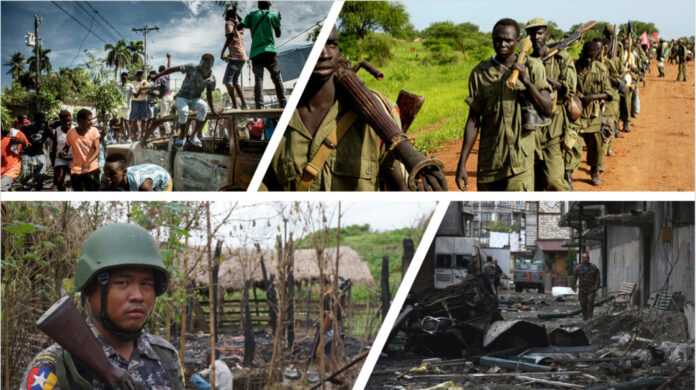At the Jesuit Roundup (and other respectable news organizations) there’s been a lot of coverage about the Ukraine and Gaza wars respectably. While these conflicts – owing to their cultural and geographic proximity to the Western world, sheer destructiveness, and access to news coverage – often get the lion’s share of media coverage, it would be a mistake to assume that the rest of the world is at peace.
Instead, it seems that Ukraine and Gaza have diverted the world’s attention from numerous other “brushfire” conflicts throughout the world. In this article, I’ll cover the more forgotten conflicts around the world existing today, the context for each event, and why they matter to us Americans today.
The Sudanese Civil War
Sudan is a country located in east Africa, just south of Egypt and northwest of Ethiopia and Eritrea. It has a diverse environment of savannas and arid mountain ranges, as well as deserts in the west but also vibrant watersheds from the Nile which runs through the center of the country. Sudan is a majority Muslim country but is split ethnically between Arab tribes that settled in the region after its conquest by Muslim forces and indigenous Sudanese African peoples.
Throughout the 1900’s, the region was beset by civil war and military coups, and in 2006 dictator Omar al-Bashir utilized arab militias to crush localized resistance groups, which devolved into genocide against dissident populations. The arab militias were given the official title Rapid Support Forces, essentially a paramilitary group in support of the dictator’s official army. By 2021, after more coups, the RSF shared power with the military but tensions rose after the military sought to absorb the RSF into its structure, thereby removing the autonomy of the military group.
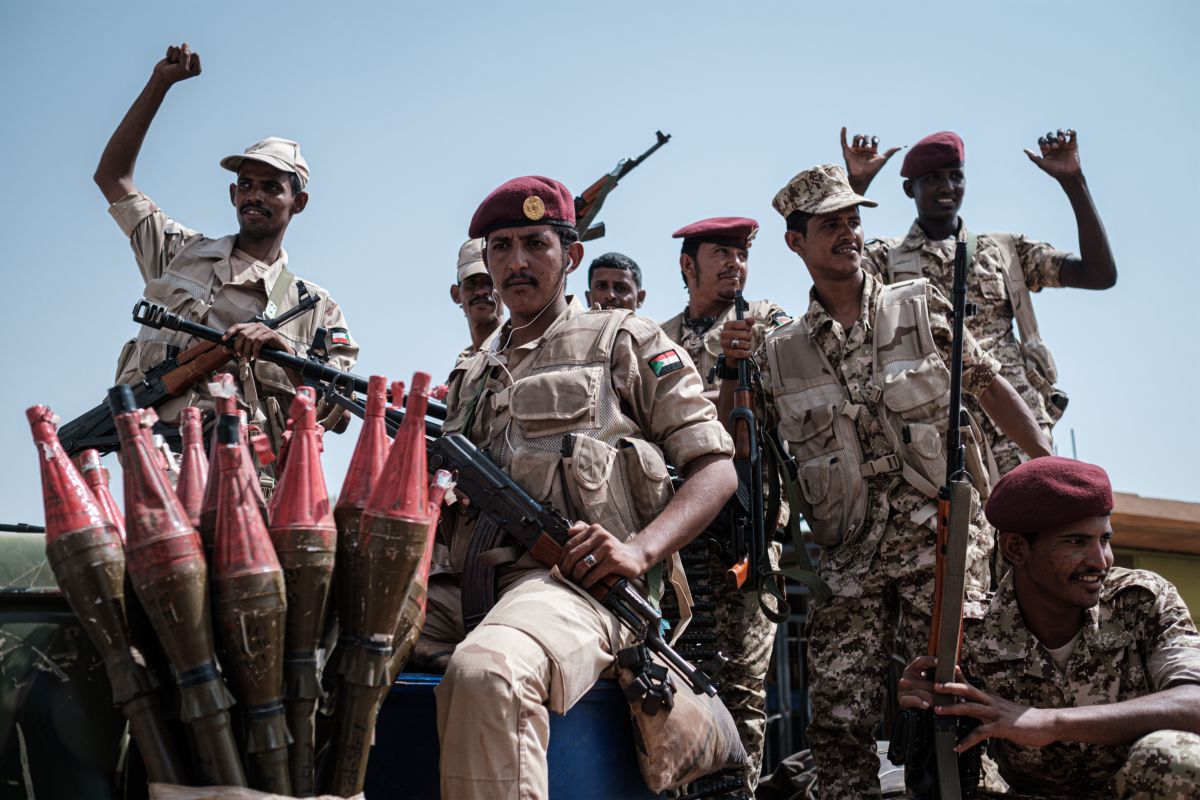
The RSF refused and fighting broke out in Khartoum, the capital in April of 2023. The RSF allied with several additional militia groups mostly based in the country’s south and west and gained ground throughout the country, but the tide of the war went back and forth until October when the RSF began to slowly gain ground in the center of the country. As of now, the RSF and Sudanese Armed Forces are at a stalemate, although the RSF is close to severing supply lines going into several SAF strongholds in the south.
Both sides have been accused, and are guilty, of horrifying crimes against the civilian populace. The RSF has been accused of ethnic cleansing in the country’s Darfur region, and the use of rape as a weapon of terror has been documented. The SAF has indiscriminately bombed cities leading to dozens of deaths, as well as the executions of captured prisoners.
The international community has declined to intervene, other than to evacuate their citizens, but the destabilized nature of Sudan means countries like Russia can deploy mercenaries to the region to secure natural resource deposits or to prop up friendly authoritarian forces. Additionally, the conflict, if it continues, will continue to pour refugees into Egypt which would further destabilize the country.

The Myanmar Coup
In 2021, the Tatmadaw – Myanmar’s military – deposed the elected president, claiming the elections were illegitimate. Within days they had established a formal military government that arrested political dissidents and suppressed news agencies from reporting on the coup.
Almost immediately, a combination of marginalized ethnic groups (fearing the military would resume past ethnic cleansing campaigns) and pro-democracy paramilitary groups rose in revolt, initially starting out as piecemeal opposition to the junta. However, over time they came to control about a third of the country, without major international assistance, whilst the Junta received arms shipments from Russia, China, and Israel.
The rebel groups are outnumbered and outgunned but possess higher morale than the junta government, and have the advantage of fighting with the widespread support of the civilian population. As of now, the onset of the ‘dry’ season in Myanmar (the absence of the monsoons which turn infrastructure into mud and make large movements of personnel and material difficult) has allowed the opposition forces to initiate a massive offensive to hopefully eject the junta in the coming months.
However, what will come after the junta is unclear. The different ethnic militias share little goals for a unified government, other than their shared hatred of the junta, and aside from the pro-democracy militias, some don’t even want to return to the pre-junta government.
The previous president, Aung Saw Suu Kyi, allowed the military to essentially mass murder Rohyinga Muslims, and was ignorant of the rising power said the military had over the parliament and elections. This new resistance movement, in the words of Vox analyst Ellen Ioanes, “is part of a potential political revolution and demonstrates a desire to break with the old, hierarchical, and exclusive governance structures — both under the Tatmadaw and the short-lived democratic transition.”
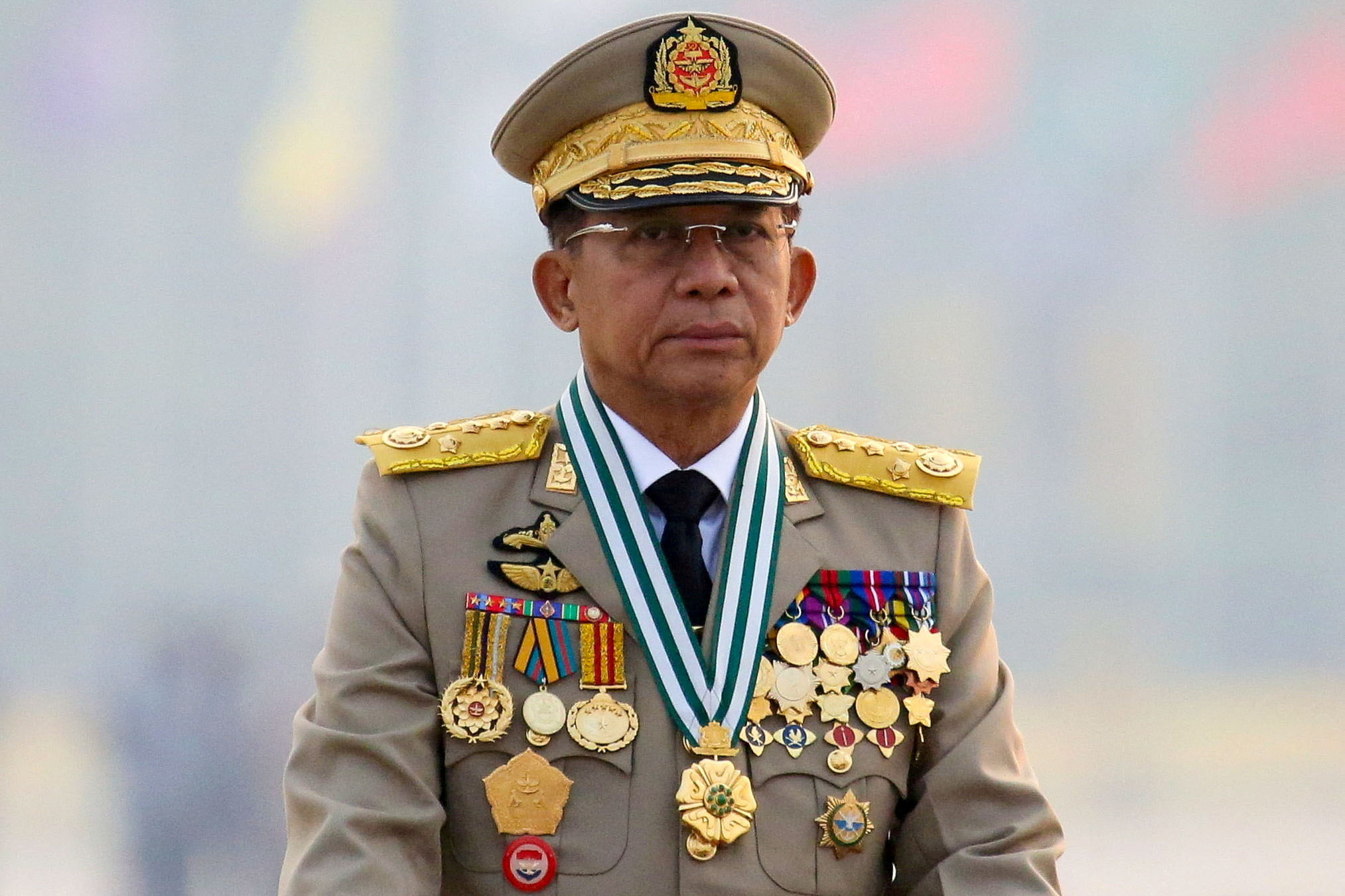
The Myanmar crisis, under the present circumstances, could destabilize neighboring states such as Thailand which are struggling to host refugees fleeing the country. Should the junta win the civil war, the new government could collapse due to infighting and a civil war could begin again.”Much as how the civil wars in Afghanistan, Iraq, Somalia, and Syria destabilized the surrounding region through spillover effects, a fragmenting and collapsing Myanmar threatens to do the same for South and Southeast Asia,” writes the George Wilson Institute.
China, seeking to establish a more pronounced presence in the region, could co-opt the nation with arms shipments and infrastructure projects to coerce the government into allowing Chinese military assets on their territory. After all, the Chinese government has sought to expand cooperation with the present military government. “No matter how the situation changes, China will support Myanmar in safeguarding its sovereignty, independence, and territorial integrity, and in exploring a development path suited to its national conditions,” said Chinese Foreign Affairs Minister Wang Yi said in April 2022.

Armenia and Azerbajian
This conflict hits a little closer to Ukraine and Israel, but has gone largely ignored by most Western commentators despite this conflict – and the region’s – importance to NATO and security in Europe. South of Russia, east of the Black and west of the Caspian Seas, the Caucasus Mountains house numerous local groups that have constantly warred over the mountains. There are the Muslim Azeris, Dagestanis, and Chechnyans in the eastern ranges and the Christian Georgians and Armenians to the west.
These countries were all under the control of the communist USSR until the 1990s when Georgia, Armenia, and Azerbaijan declared independence. Russia couldn’t hold onto these 3 nations, but while it tried to keep Chechnya into the fold through a ruthless military crackdown, Armenia took the opportunity to seize Azeri territory that was majority Armenian, known as Nagorno-Karabakh, and defeated the Azeris in a 6-year long conflict. But the Azeris, backed by their fellow Muslims in Turkey, never forgot the humiliation.
With Armenia still in possession of the autonomous state as well as surrounding Azeri territory (which was not majority Armenian), Azerbaijan launched an attack in 2020 that sought to seize Nagorno-Karabakh and the lost territory from 1994. Utilizing Turkish-made drones and a revitalized army, they beat the Armenians handily, who despite their superiority in infantry suffered from poor logistics, command and control, and an inability to conduct combined arms warfare.
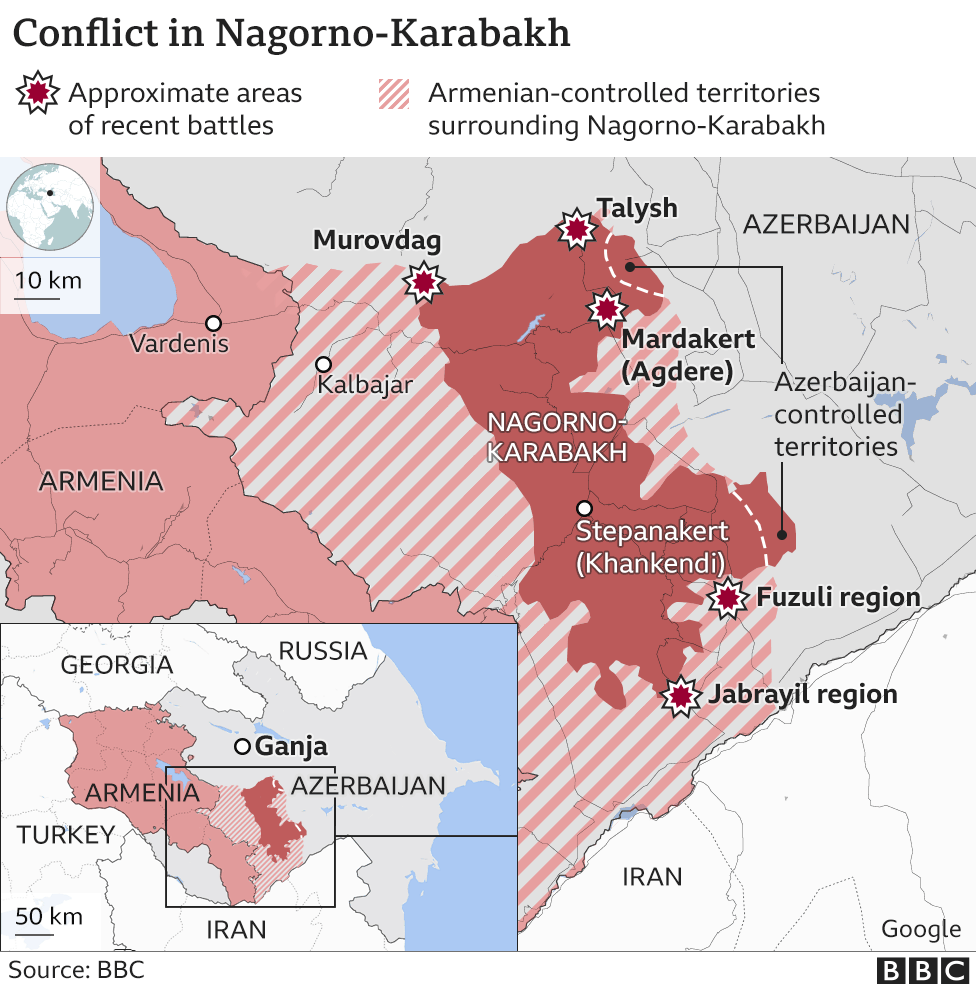
The Azeris recaptured lost territory but left the original Armenian enclave intact, until in 2023 they speedily captured the region leading to the movement of 100,000 ethnic Armenians west towards their fellow citizens. These two humiliating defeats for Armenia emboldened Azerbaijan to take further action against Armenia, to take more territory claimed by the former, as stated by the Azeri president.
Until recently, Russia backed the Armenians as a part of a wider regional security council named the Collective Security Treaty Organization (CSTO) made up of Russian allied nations, but when Russia failed to intervene to assist Armenia despite the latter’s pleas, relations were frayed. After their dual defeats, Armenia has sought to increase military cooperation with the United States, which it sees as being a far more reliable security partner.
However, Azerbaijan is supported by Turkey – a member of the North Atlantic Treaty Organization and thus a US ally – making the situation difficult. Should war resume, we could see NATO be split between pro-Azeri and pro-Armenian factions, threatening alliance unity at a key moment when unified aid to Ukraine in order to collapse Russian military power remains paramount. Additionally, continued conflict could allow Russia to exert more influence in the region to bolster its flagging relationship with Armenia, establishing a bulwark against greater NATO influence in the Caucuses.
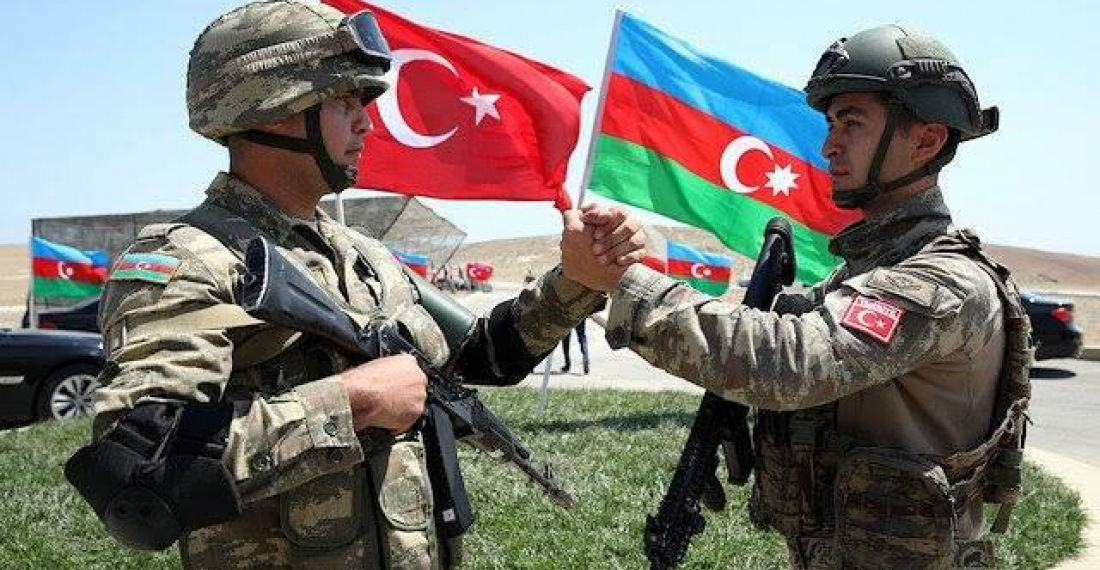
The Failed State of Haiti
Haiti was first colonized by the Spanish, then the French, and utilized to grow sugar cane with its rich soil. Imported African slaves made up the majority of the population and were treated abhorrently, leading to a massive slave uprising that saw local French citizens slaughtered and the independence of the Haitian state.
The Haitians created a kingdom and remained relatively isolated from their neighbors due to racism against the former enslaved, but in the 1900s the United States occupied the nation but left in 1934, leaving the country to a series of dictators that did nothing to alleviate horrifying levels of poverty. Beginning in 2004, a number of natural disasters hit the nation such as numerous tropical storms, and finally, in 2010 a devastating earthquake that killed 250,000 and made nearly a million homeless as well as destroying local infrastructure.

Inundated with poverty, the economy collapsed and the government lacked revenue to establish security or infrastructure in the region, exacerbating these woes. In the chaos armed gangs established regional jurisdiction, running the black market and stealing much of the humanitarian aid sent to Haiti. In 2021 the president was assassinated and much of the government simply left their offices, without guarantees of salaries, payment, or communications infrastructure to rule the country.
“Dengue and malaria run rampant, and cholera, introduced by UN peacekeepers from Nepal after the 2010 earthquake, has killed almost ten thousand people and infected nearly one million more. Despite declaring itself cholera-free in 2022, a lack of access to healthcare and other essential services is fueling a resurgence of the disease across the island. At the same time, billions of dollars in aid pledges from governments and organizations following the 2010 crisis are still unaccounted for,” cites the Council on Foreign Relations.
The Haitian Prime Minister at one point openly called for a US military intervention, even though past track records of intervention have been less than flattering. Currently, the Kenyan and Canadian governments appear lukewarm to the idea and would be the primary funders of a peacekeeping mission. However, there have been domestic refusals inside both nations to such an effort, and a full-fledged intervention is therefore highly unlikely.
Haiti’s instability likely remains the scenario with the most amount of lives at stake. Millions of civilians in perpetual poverty, with armed gangs extorting them and constant natural disasters threatening the deaths of thousands, means that there is an ethical obligation to seek aid, but how the world can do so is not a simple one. Should the crisis continue, Haiti could become a safe haven for drug or weapons smuggling. The increasing levels of political instability and economic deprivation, in the words of immigration policy analyst Valerie Lacarte, “would lead to increased levels of migrants whose humanitarian needs are not being recognized or respected by a range of host countries.”
Increasing levels of these migrants lead to pushback from host countries, possibly motivated by the African heritage of said Haitian migrants, which leads to “Repatriations to Haiti… further destabilizing an already vulnerable country and making future [migration] more likely.”

Conclusion
The conflicts outlined above present daunting challenges to US foreign policy as we enter an international arena truly connected through economic, cultural, and informational medians. Any one of these conflicts has the potential to kick off a larger military confrontation and further escalation. However, the United States can adopt a number of measures towards these regional hotspots to advance national interests and de-escalate tensions.
The first potential course of action would be to fully detach from interference in these regions and refocus on strategic locations that better fit our national interests, such as Europe, East Asia, or the Middle East. This has partly been the present course of action in regions like Myanmar, Haiti, or the Sudanese Civil War. The US Government not intervening in these nations might only prolong the conflict and sour the public opinion of the Americans, as seen in the Libyan and Iraqi interventions. Instead, coordination through humanitarian international institutions, such as the World Trade Organization or Red Cross, could allow for lives to be saved whilst avoiding unneeded political interference.
.jpg)
Another road to take would be an interventionist policy to crush hostile groups antithetical to American values or interests. The dictatorship of Myanmar or Sudan, for example, has in the past harbored Russian and Chinese military assets, threatening not only the American position in those regions but also our allies. Whether through active kinetic strikes through air or sea assets, or funding of opposition groups to topple opposing forces, America could assist partner forces in restoring order to their country. This would be in the form of training, equipment donations, and/or localized strikes on enemy positions. This would not be nation-building, as the US Defense and State Departments in their present state are entirely unfit to conduct such an operation, but rather a handholding process of shaping the conflict to our advantage. Such work has already been the staple of American policy in dealing with threats like ISIS or Boko Haram, now may be the time to apply it to Haiti or Myanmar.
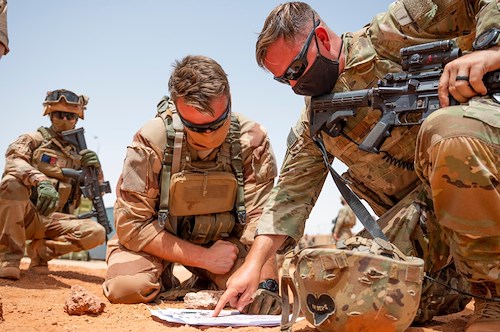
The final solution would be to, for the sake of preserving lives and resources, acknowledge existing government forces and work with them to further the security of the region. For nations like Armenia or Azerbaijan, engagement with both nations whilst utilizing our diplomatic forces to forge peace agreements would be a slow but potentially more effective way to mediate conflict in the region. For empirical examples, see Vietnam or India, nations that have had hostile or lukewarm ties with the United States throughout the 1900’s, but now have been steadily gravitating towards becoming future allies.

I hope the above ideas could conceptualize the potential for future US engagement in these regions. I think a combination of all three policy prescriptions would best suit US interests, as none of the outlined conflicts are truly the same. Some, such as the Nagorno-Karabakh war, were fought between two functioning states with developed militaries. An approach to that conflict would ideally resemble that of the NATO peacekeeping missions to the Balkans, focused more on political engagement than nation-building. For the failed state of Haiti, a formalized peacekeeping force, with permission to hunt down and destroy armed gangs has the potential to restore law and order in the region. And for Myanmar, watchful neutrality may serve the US best.
Anyway, the above comments are just my personal views on the issue. I see international relations as being a combination of an analysis of the past, applications to the present, and predictions for the future. International Relations seeks to embrace a holistic approach to countering world problems, and especially now, we need all the tools at our disposal to make the world a safer place.
Stay tuned to the Jesuit Roundup for more Global Affairs Coverage!


